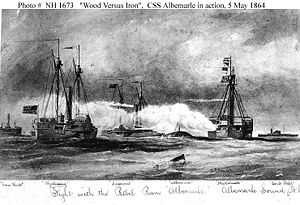USS Mattabesett (1863)
 The Battle of Albemarle Sound. Mattabesett is second from right | |
| History | |
|---|---|
| Name | USS Mattabesett |
| Builder | A. & G. T. Sampson, Boston, Massachusetts |
| Laid down | 1862[1] |
| Launched | 1863[1] |
| Commissioned | 7 April 1864 |
| Decommissioned | 31 May 1865 |
| Fate | Sold, 15 October 1865 |
| General characteristics | |
| Class and type | Sassacus-class gunboat |
| Displacement | 1,173 long tons (1,192 t) |
| Length | 205 ft (62 m) |
| Beam | 35 ft (11 m) |
| Draft | 8 ft 6 in (2.59 m) |
| Installed power | 1 × 712 ihp inclined direct-acting steam engine, auxiliary sails |
| Propulsion | 2 × sidewheels |
| Sail plan | Schooner-rigged |
| Speed | 14 knots (26 km/h; 16 mph) |
| Complement | 100 officers and enlisted |
| Armament |
|
USS Mattabesett, sometimes spelled Mattabeset, a schooner-rigged, wooden hulled, double-ended sidewheel gunboat, was built by A. & G. T. Sampson, Boston, Massachusetts, and named for the Mattabesset River in Connecticut. Mattabesett was delivered to the New York Navy Yard on January 18, 1864, and commissioned April 7, 1864, Commander John C. Febiger in command.
Service history
Mattabesett departed New York on April 21, 1864, for duty in the North Atlantic Blockading Squadron and arrived at Hampton Roads on April 23 as escort to USS Onondaga. Continuing down the coast to enter the North Carolina Sounds, she took part in an engagement between Union forces and the Confederate ram CSS Albemarle, accompanied by CSS Bombshell and CSS Cotton Plant, off the mouth of the Roanoke River on May 5. In the course of the battle, leading to the capture of Plymouth, North Carolina by Confederate forces, Mattabesett, with USS Sassacus, captured Bombshell, but Albemarle and Cotton Plant escaped.
But for a brief trip to New York in the fall of 1864, Mattabesett continued to serve the North Atlantic Blockading Squadron for the remainder of the U.S. Civil War, operating primarily in the inland waters of North Carolina. She sailed north in May 1865, decommissioned at New York on May 31, and was sold there on October 15.
See also
Ships captured in the American Civil War
Footnotes
References
- Bauer, Karl Jack and Roberts, Stephen S. (1991): Register of Ships of the U.S. Navy, 1775-1990: Major Combatants, Greenwood Publishing Group, ISBN 978-0-313-26202-9.
 This article incorporates text from the public domain Dictionary of American Naval Fighting Ships. The entry can be found here.
This article incorporates text from the public domain Dictionary of American Naval Fighting Ships. The entry can be found here.
External links
- Photo gallery at Naval Historical Center
